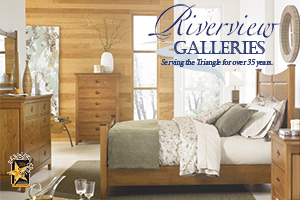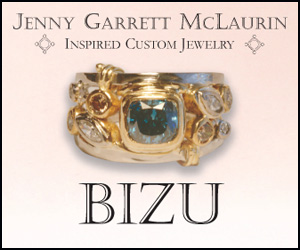Made in the Shade
A lamp's topper can make or break a room
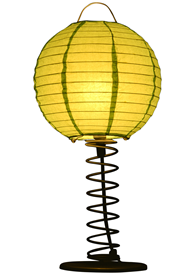
By now, if you have more than a passing interest in home-makeover shows and decorating magazines, you know a thing or two about how color can change a room, how a few great throw pillows can work magic and how artfully arranged accessories are essential.
But lampshades? They're an afterthought at best.
"So many people tend to go off-white and bland with their shades," says interior designer Barbara Eberlein. "They don't understand how much of an impact lampshades can make."
A great one can wake up a space, says Margie Willis, co-owner of a lamp store.
"You can spend thousands on a room, and the first thing people see is what's lit."
Beautifully colored or patterned shades can give a room a warm, finished look, designers say, and the way a shade diffuses or focuses light can create drama.
A striking shape can turn even a pedestrian lamp into a sculptural object.
Adding trim, such as beads, fringe, ribbon or silk cord (known as soutache) is an easy way to raise the luxury factor.
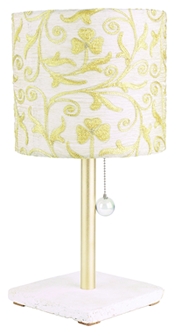
Sure, such shades are more expensive than the limited styles found in places such as Bed Bath & Beyond. Custom-made, handsewn, real silk versions can start at $250, without trim, but they'll last for decades.
Plenty of high-end, ready-made shades are also available at better lamp stores in the $50 to $150 range-in colors, patterns and styles that can bring that wow factor into any room.
"One thing people do wrong is they find a shape they like and put it on all the lamps in the room," Eberlein says. "But a shade always needs to relate to the lamp it's on."
Standard shapes include drum, empire (a tapered drum), coolie (named for the flattened Asian hats)
and bell.
On the more elaborate (and usually more expensive) side are squared bells, Maltese bells (with a scalloped, flower-like bottom edge), octagons and pagodas (which mimic the roof shape seen in Asian architecture).
Becoming increasingly popular, thanks to the interest in mid-century-modern furnishings, is the retro drum-a sleek, shortened version of the drum, which became massively oversized in the 1970s.

While there are some common pairings (ginger-jar lamps with coolie shades, candlestick lamps with empire shapes, for example), matching a shade to a lamp is more art than science, Eberlein says.
"If you open the design rule book, it says to use an oval shade on an oval base, and a round shade on a round base."
But, rules are made to be broken. Just keep this in mind: Whatever shade you choose, pay attention to proportion.
"A lot of people make the mistake of having a lampshade that is too big or too small for the base," says Willis.
One rule of thumb is that a shade should be no smaller than one-third the height of the base.
If your lamp looks in danger of toppling over, you probably need a smaller shade.
"People always think they need these big shades on standing lamps," Willis says, "but they don't; and they can be almost any shape."
Where a shade hits on a lamp is important. 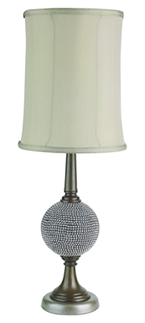 Shades should cover the hardware on the lamp, and just skim the top of the lamp base.
Shades should cover the hardware on the lamp, and just skim the top of the lamp base.
The key to getting the height correct is using the right harp, Willis says.
These U-shaped pieces of metal, which fit into the sides of the bulb socket and hold up the shade on most lamps, come in increments from 6 inches to 12 inches.
There are also risers that can help raise a shade without changing the harp.
People often think a shade is not suited to a lamp, when actually all they need is a new harp or riser, Willis says.
At her shop's workroom, she offered a lesson in a lampshade's power to transform a run-of-the-mill lamp into something exceptional.
First, she put a pleated, white coolie shade on an inexpensive black, ceramic ginger-jar lamp. Safe and boring.
But, with a scarlet retro-drum shade, that same lamp looked intriguingly modern and way more interesting.
A stovepipe square shade in a narrow, burgundy-and-gold stripe gave the lamp another sort of modern look. Add a silk tassel, and it gained a 1930s aura. Garbed
in a handmade celadon-green silk shade, set on a carved wooden base, draped with a silk tassel and topped with a jade finial, the plain-old lamp looked like an
heirloom.
Finials-the decorative pieces that screw to the top of the harp and keep the shade in place-are another key accessory.
They can range from $6 for a simple colored-glass ball to up to $100 for a jade, crystal, painted ceramic or brass version.
Finials can match the lamp or the shade, or they can be used to pick up another color in the room, Willis says.
"They're like earrings; they finish off the outfit."
The right material for a shade depends on how the lamp will be used, Eberlein says.
"Is it for reading? That's a different need than if you want a general glow in the room."
For that, you'll need something like silk, which diffuses light.
A paper or fabric shade will focus light.
Patty Blum, another lamp-shop owner, offers some advice for maintaining your shades: Never vacuum them.
The suction is too much, even for the best-made shades.
"Get a soft paintbrush and dust the shade at least once a month," she says.
Since sunlight can affect lampshades, rotate those positioned near bright windows
to avoid uneven fading.
Also, if one of a pair of matching shades gets more sun, exchange one for the other regularly.
©2007 KNIGHT RIDDER NEWPAPERS
DISTRIBUTED BY TRIBUNE MEDIA SERVICES INC.

